P-38 Lightning
Models
Modèle de pré-série seulement produit à 30 exemplaires. Il était armé de quatre mitrailleuse de 12.7 mm et d'un canon et d'un blindage peu épais. Un des premiers P-38 sans turbo-compresseurs fut doté d'un cockpit secondaire placé sur un des fuselage afin d'étudier la possibilité d'un poste de pilotage « asymétrique ».
Pre-production model produced only to 30 copies. It was armed with four machine gun of 12.7 mm and one 37 mm gun and a little thick shielding. One of the first P-38 without turbo-compressor was equipped with a secondary cockpit placed on one of the boom in order to explore the possibility of a "asymmetric" cockpit position
 |
P-38 Lightning |
src: WWII
Fighters |
Data |
Drawings |
Modèle très similaire encore au P-38. Il était cependant doté d'un blindage plus épais, de réservoirs auto-obturables, de phares et également d'un système d'oxygène basse-pression. Produit à 36 exemplaires.
Model very similar to the P-38 again. It was however endowed with thicker armor, self-sealing tanks, headlights and also a low-pressure oxygen system. 36 copies realized.
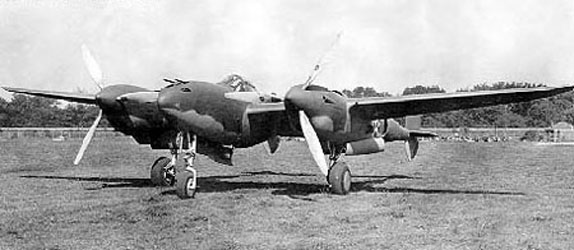 |
P-38D Lightning |
src: WWII
Fighters |
Data |
Drawings |
Premier modèle vraiment opérationnel mais très similaire au précédent. Cependant son canon principal de 37 mm est remplacé par un canon de 20 mm. Le système hydraulique est également amélioré. Produit à 210 exemplaires..
First model really operational but very similar to the previous model. However its 37 mm main gun was replaced by a 20 mm cannon. The hydraulic system is also improved. 210 copies realized.
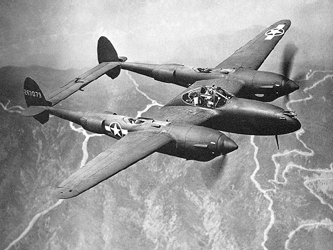 |
P-38E Lightning |
src: WWII
Vehicles |
Durant la guerre du Pacifique, il fut proposé de convertir le P-38E en hydravion de chasse pouvant parcourir de longue distance (dans l'idée d'assurer les livraisons rapides aux unités). Pour les combats, les flotteurs pouvaient être largués pour alléger l'appareil. Pour préserver les stabilisateurs de la corrosion, les empennages furent surélevés d'environ 41-46 cm (voir photo ci-dessous, à gauche). Notons qu'un deuxième siège fut ajouté pour un observateur. D'autres configurations furent envisagées, mais l'idée d'un Float Lightning fut rapidement abandonné, l'US Navy estimant qu'elle possédait assez de ressources logistiques pour assurer les livraisons de P-38 standard dans le Pacifique Sud.
During the Pacific war, it was proposed to convert the P-38E in float fighter that can travel long distance (in the idea to ensure fast deliveries to units). For fighting, floats could be jettisoned to lighten the aircraft. To preserve corrosion of stabilizers, tail panels were raised approximately 41-46 cm (pictured below, left). Note that a second seat was added for an observer. Other configurations were considered, but the idea of a Float Lightning was quickly abandoned, the U.S. Navy felt that it had enough logistical resources to ensure supplies of P-38 standard in the South Pacific.
Un P-38E fut équipé d'une nacelle
centrale allongée pour accueillir un habitacle biplace avec doubles
commandes. Cet appareil expérimental fut également dotés
d'extrémités d'aile à écoulement laminaire
(voir photo ci-dessous, à droite).
A P-38E was fitted with an elongated central nacelle to accommodate a two-seater cockpit with dual controls. This experimental craft was also equipped with laminar wing tips (pictured below, right).
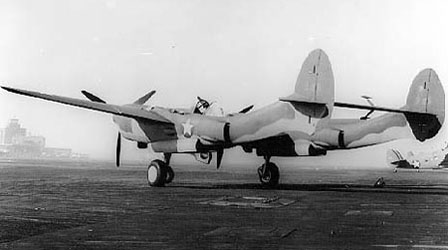 |
 |
P-38E avec queue relevée. |
P-38E "Swordfish" équipé
avec une aile laminaire spéciale. |
P-38E with raised tail. |
P-38E "Swordfish"
equipped with a special laminar wing. |
src: WWII
Vehicles |
src: WWII
Fighters |
D'autres P-38E furent utilisés en 1942 comme tracteurs pour les planeurs Waco des troupes aéroportées. Cependant comme d'autres avions comme le C-47 était largement disponibles pour cette corvée, le P-38 en fut largement dispensé.
Other P-38E were used in 1942 as tractors for the airborne troops Waco gliders. However as other planes like the C-47 was widely available for this chore, the P-38 in was widely taught.
Data |
Drawings |
Sur ce modèle on ajouta des pylônes pour pouoir transporter des bombes ou des réservoirs supplémentaires largables. Des modifications furent aussi effectuées sur les volets. Produit à 527 exemplaires.
On this model was added hardpoints to carry bombs or additional drop tanks. Changes were also made to the flaps. 527 copies realized.
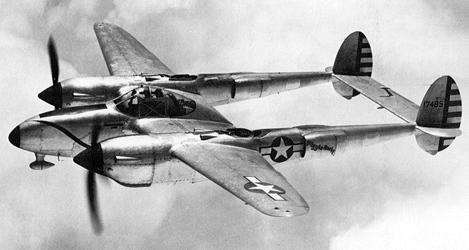 |
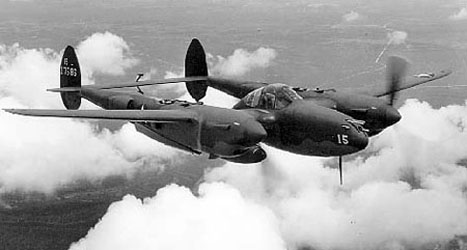 |
P-38F Lightning |
|
src: WWII
Vehicles |
src: WWII
Fighters |
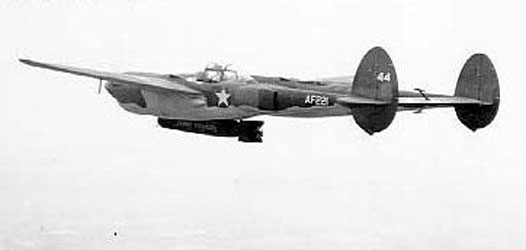 |
P-38F équipé d'une une torpille
factice pour des tests. |
P - 38F equipped
with a dummy torpedo for testing. |
src: WWII
Fighters |
Data |
Drawings |
Modèle similaire au précédent mais doté de moteurs plus puissant, des Allison V-1710-51/55 de 1400 ch. Produit à 1082 exemplaires.
Model similar to the previous but with engines more powerfull, Allison V-1710-51/55 of 1400 hp. 1082 copies realized.
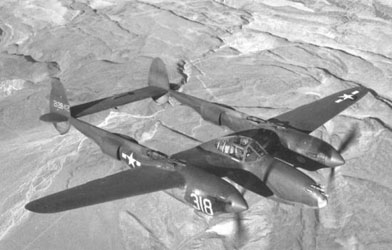 |
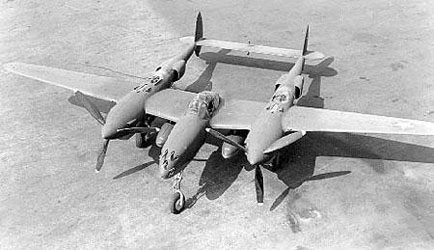 |
P-38G Lightning |
|
src: WWII
Fighters |
src: WWII
Fighters |
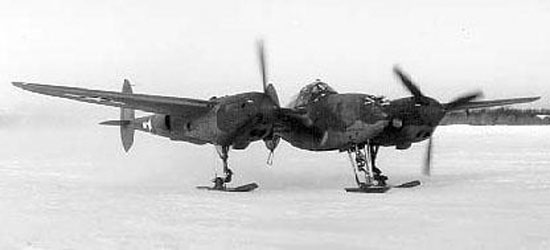 |
P-38G équipé de skis retractable.
N'atteignit jamais le stade opérationnel. |
P-38 G equipped
with retractable skis. Never reached operational service. |
src: WWII
Fighters |
Data |
Drawings |
Modèle doté d'une structure renforcée pour emporter une charge plus importante. Modèle aussi équipé de deux nouveaux moteurs Allison V-1710-89/91 de 1475 ch. Produit à 601 exemplaires.
Model equipped with a reinforced structure to carry a larger payload. Model also equiped with two new engines Allison V-1710-89/91 of 1475 hp. 601 copies realized.
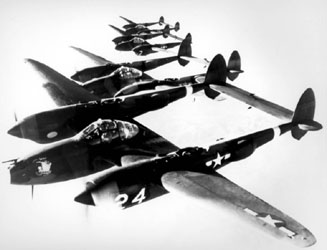 |
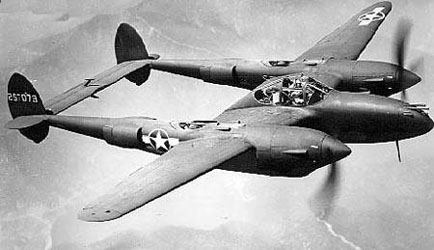 |
P-38H Lightning |
|
src: Wikipedia |
src: WWII
Fighters |
Certains P-38 furent transformés en Droopsnoots (ou éclaireur de bombardement). Ces appareils étaient dotés d'un nez vitré, acceuillant un viseur de bombardement Norden ou un radar H2X de bombardement. Les Droopsnoots dirigeaient une formation de P-38 transportant chacun deux bombes de 907 kg. Ces derniers suivant les indications du Droopsnoot.
Some P-38 were converted into Droopsnoots (or Scout bombing). These machines were equipped with a glazed nose with a bombing Norden sight or a bombing H2X radar. The Droopsnoots leaded a formation of P-38 each carrying two bombs of 907 kg. These following the indications of the Droopsnoot.
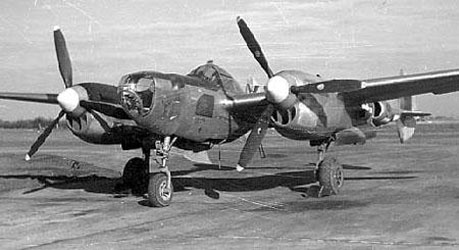 |
P-38H "Droopsnoot" |
src: WWII
Fighters |
Data |
Drawings |
Sur ce modèle, plusieurs changements majeurs sont effectués. Pour améliorer le refroidissement, de plus gros radiateurs sont installés. La capacité des réservoirs est augmentée, ainsi que la résistance et la visibilité de la verrière. De nouveaux volets de descente et ailerons, à assistance hydraulique sont installés. Produit à 2970 exemplaires.
On this model, several major changes. To improve cooling, bigger radiators are installed. The capacity of the tanks is increased, as well as the strength and visibility of the canopy. New ailerons and flaps of descent, hydraulically assisted are installed. 2970 copies realized.
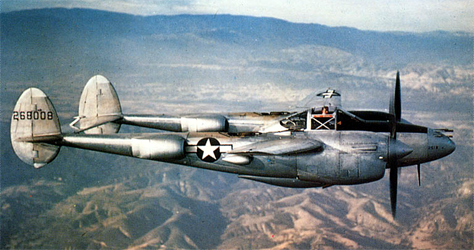 |
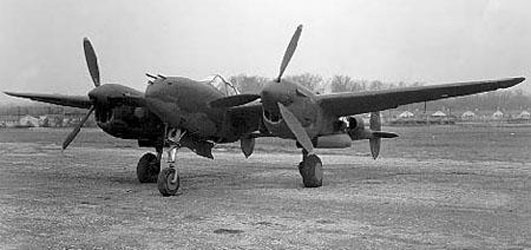 |
P-38J Lightning |
|
src: WWII
Vehicles |
src: WWII
Fighters |
Une solution acrobatique fut tentée pour permettre le ravitaillement en plein vol. Le P-38 devait récupérer un réservoir largable trainé au bout d'un cable par un bombardier. Cette solution fut jugée peu pratique et rapidement abandonnée.
A freestyle solution was tempted to allow refuelling in mid-flight. The P-38 was to retrieve a drop tank trailed at the end of a cable by a bomber. This solution was considered to be impractical and quickly abandoned.
Data |
Drawings |
Modèle doté de moteurs V-1710-75/77 et d'hélices modifiées. Un seul exemplaire produit.
Model with V-1710-75/77 engines and modified propellers. A single copy realized.
Modèle quasiment identique au P-38J mais doté de moteurs V-1710-111/113. Installation de phares d'atterissage dans les ailes et de 2 pylones pour 10 roquettes. Produit à 3810 exemplaires par Lockheed (+113 par Vultee).
Model almost identical
to the P - 86J but with engines V-1710-111/113. Installation of headlights
of landing in the wings and 2 hardpoints for 10 rockets. 3810 copies realized
by Lockheed (+113 by Vultee)..
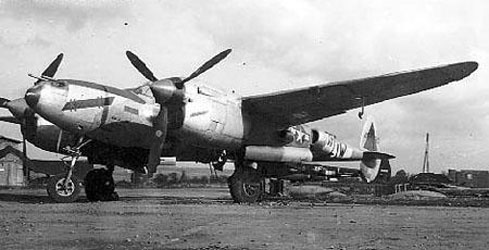 |
P-38L Lightning |
src: WWII
Fighters |
Data |
Drawings |
P-38L convertis en chasseur de nuit biplace, le radar étant installé dans une nacelle sous le nez. Les appareils en opération seront peints en noir. Produit à 75 exemplaires.
P-38 L converted into two-seat night fighter, the radar is installed in a nacelle under the nose. Craft in operation will be painted in black. 75 copies realized.
-ww2fighters.jpg) |
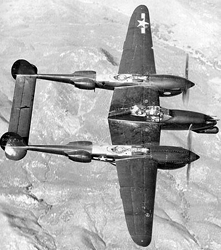 |
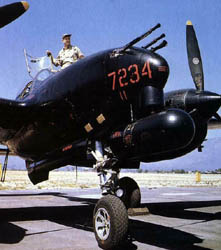 |
Prototype of P-38M Lightning |
P-38M Lightning |
|
src: WWII
Fighters |
src: WWII
Vehicles |
src: WWII
Fighters |
Data |
Drawings |
Version de reconnaissance-photo du P-38E, produite à 99 exemplaires. Equipé de 4 appareils photos K-17 dans le nez à la place de l'armement.
Version of photo-reconnaissance of the P-38E, produced to 99 copies. Equipped with 4 cameras K-17 in the nose instead of weapons.
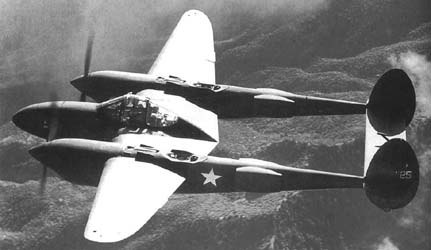 |
F-4-1-LO
|
src: Aerostories |
Drawings |
Version de reconnaissance-photo du P-38F, produite à 20 exemplaires. Equipé de 4 appareils photos K-17 dans le nez à la place de l'armement.
Version of photo-reconnaissance of the P-38F, produced to 20 copies. Equipped with 4 cameras K-17 in the nose instead of weapons.
Drawings |
Version de reconnaissance-photo du P-38G, produite à 20 exemplaires pour le F-5A-1, 140 exemplaires pour le F-5A-10, 1 exemplaire pour le F-5A-2 (attention, basé sur le P-38E). Un F-5A-10-Lo(XF-5D) sera doté d'un nez en plexiglas et poste d'observation ainsi qu'un appareil photo vertical et deux mitrailleuses de 12.7 mm.
Version of photo-reconnaissance of the P - 38G, produced to 20 copies for the F-5A-1, 140 copies for F-5A-10, 1 copy for the F- 5A-2 (attention, based on the P-38E). A F- 5A-10-LO (XF-5D) will be equipped with a nose in Plexiglas and observation post as well as a camera vertical and two 12.7 mm machine guns.
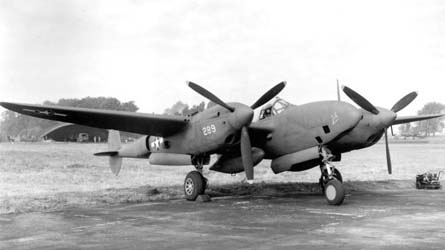 |
F-5A
|
src: Wikipedia |
Drawings |
Version de reconnaissance-photo du P-38J, produite à 200 exemplaires. C'est sur ce type d'avion que volait Saint-Exupéry lors de sa disaparition en mer en 1944. Cinq F-5B seront livrés à l'US Navy et utilisés en Afrique du Nord sous le nom de XFO-1.
Version of photo-reconnaissance of the P - 38J, produced to 200 copies. It is on this type of aircraft that was flying Saint-Exupery at his disaparition in sea in 1944. Five -5B will be delivered to the US Navy and used in North Africa under the name of XFO-1.
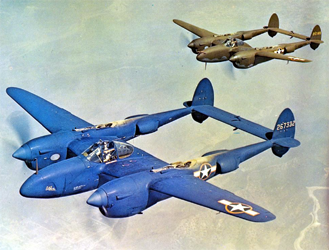 |
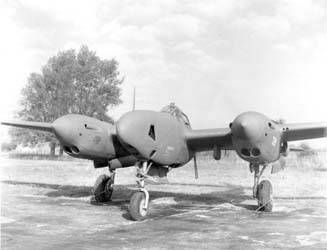 |
F-5B
|
|
src: WWII
Vehicles |
src: WWII
Fighters |
Drawings |
Version de reconnaissance-photo du P-38H, produite à 123 exemplaires.
Version of photo-reconnaissance of the P-38H, produced to 123copies.
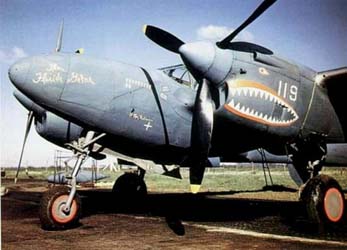 |
F-5C
|
src: WWII
Fighters |
Drawings |
Autre version de reconnaissance-photo du P-38J (excepté pour le F-5E-4 basé sur le P-38L), produite à 705 exemplaires.
Another version of photo-reconnaissance of the P-38J (except for the F-5E-4 based on the P-38 L), produced to 705 copies.
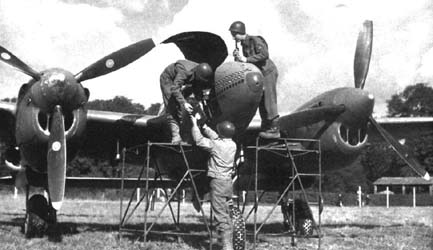 |
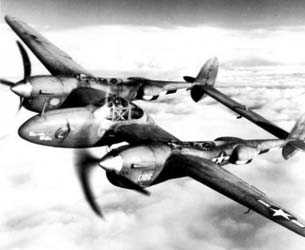 |
F-5E
|
|
src: Aerostories |
src: WWII
Fighters |
Drawings |
Version de reconnaissance-photo du P-38L.
Version of photo-reconnaissance of the P-38L.
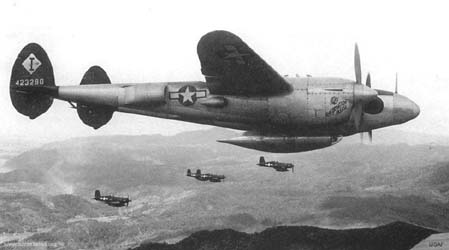 |
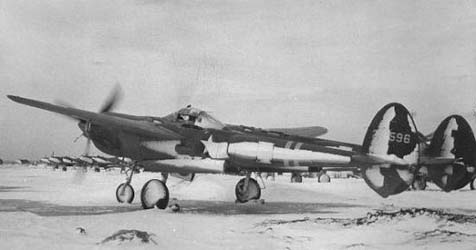 |
F-5F
|
|
src: Aerostories |
src: WWII
Fighters |
Identique au F-5F-3 mais avec des appareils photos différents.
Identical to the F-5F-3 but with different cameras.
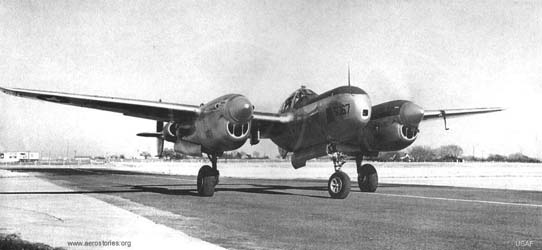 |
F-5G
|
src: Aerostories |
Drawings |
Ce sont les Lightning produits pour la Grande Bretagne, dont 3 seulement seront livrés, le reste étant utilisé pour l'entraînement des pilotes américains.
Lightning realized for Great Britain, only 3 will be delivered, the rest being used for training of American pilots.
Drawings |
Il fut envisagée de convertir le P-38 en chasseur aéronaval capable d'opérer sur des porte-avions. Cette version devait être doté d'ailes repliables, d'une crosse d'apontage et d'un train d'aterrisage renforcé. Cependant la Navy jugea le Lightning trop large pour opérer sur un porte-avion, et elle était peu enthousiaste par rapport au moteur à refroidissement liquide. Le projet resta donc au stade "papier".
It was planned to convert the P-38 in shipborne fighter capable to operate from aircraft carriers. This version was to be equipped with folding wings, a arresting hook and a reinforced landing gear. However the Navy ruled the Lightning too wide to operate on an aircraft carrier, and was unenthusiastic over the liquid-cooled engine. The project remained in the 'paper' stage.
Other Conversions and Developments
Des F-5B furent utilisés comme transport de personnel (ou de fret) rapide dans le Pacifique Sud. Ici le confort est totalement absent puisque les passagers (deux personnes) étaient transportées allongées dans des nacelles étroites suspendues sous les ailes de part et d'autres de la nacelle centrale. Ces nacelles disposait d'un fenêtre à l'avant. Il fallait un certain courage pour monter là-dedans. Quelqu'un dit un jour que celui qui avait inventé cela aurait dû être forcé de monter dedans (et voyager ainsi bien entendu).
Certain F-5B were used as personnel (or cargo) fast transport in the South Pacific. Here, comfort is entirely absent since passengers (two people) were transported elongated in narrow pods suspended under the wings of share and others of the Central nacelle. These pods had a window on the front. It took some courage to climb in. Someone said that who had invented this should have been forced to fit in (and travel as well of course).
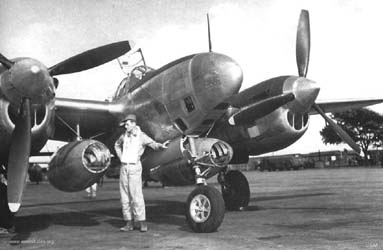 |
F-5B modifié de façon à
pouvoir transporter les hommes dans des nacelles installées
sous les ailes. |
F-5B modified to carry
men in nacelles installed under the wings.
|
src: Aerostories |
Développement du P-38, durant 1942-1943. Cet appareil expérimental était doté des nouveaux moteurs de 24-cylindres Pratt & Whitney X-1800, d'un cockpit pressurisé et d'un armement composé de deux canons de 20 mm (.79 in) et de quatre mitrailleuses de 12.7 mm (.50cal). Les moteurs seront remplacé plus tard par deux Continental XI-1430-1 (ou IV-1430). L'appareil n'offrant pas assez d'améliorations par rapport au P-38, il fut jugé inutile de perturber la chaine de production et le projet fut abandonné.
Development of the P-38, during 1942-1943. This experimental aircraft was equipped with the new engines of 24-cylinder Pratt & Whitney X-1800, a pressurized cockpit and an armament of two 20 mm (.79 in) guns and four machine guns of 12.7 mm (.50cal). The engines will be replaced later by two Continental XI-1430-1 (or IV-1430). The aircraft does not offer enough improvements over the P-38, it was deemed unnecessary to disturb the production chain and the project was abandoned.
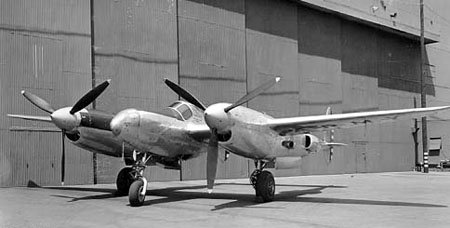 |
XP-49
|
src: Wikipédia |
XP-49
Specifications |
| General |
Type:
Heavy fighter |
| Engine |
| 2 × Continental XI-1430-1 V12 engines | 1600 hp | Pistons |
| Dimensions/Masses |
| Length: 12.2 m | Width:
15.8 m | Height: 3 m Weight: 6990 kg | Max. Combat Weight: 8505 kg |
| Performances |
| Max. Speed: 653 km/h | Ceiling: ? m| Range: 679 km |
| Armament |
Guns:
2 x 20 mm (.79in) gun & 4× .50 in (12.7 mm) M2 MG |
Drawings |
Développement du Lockheed P-38 Lightning, destiné à être exporté vers l'Angleterre et la France et fourni dans une version plus avancée à l'USAAF. Il a été envisagé en deux versions : une monoplace et une version biplace (ayant chacune des canons de queue). Le projet fut rapidement modifié (probablement la raison principale pour la longueur excessive du développement), la version monoplace fut abandonnée, et les armes de queue remplacés par une tourelle dorsale. Un certain nombre de changements de moteurs plus tard (et l'ajout d'une tourelle ventrale), le projet XP-58 a été une nouvelle fois modifié pour être devenir un avion d'attaque au sol. Après que plusieurs nouvelles configurations d'armement ont été envisagées, la raison d'être de l'avion fut encore une fois modifiée en "destructeur de bombardiers ». Après de nouvelles modifications apportées, au moment où le premier prototype fit son vol inaugural (après un développement prolongé de quatre ans), le besoin d'un "chasseur de bombardiers" n'était plus nécessaire et le projet fut abandonné en 1945.
Development of the Lockheed P-38 Lightning, intended to be exported to England and the France and provided in a more advanced version to the USAAF. It was envisaged in two versions: a single-seater and a two-seater (with tail guns). The project was quickly altered (probably the main reason for the excessive length of the development), the single-seater version was abandoned, and weapons of tail replaced by a dorsal turret. A number of engines changes later (and the addition of a ventral turret), the XP-58 project has once again changed to become a ground-attack aircraft. After several new armament configurations were considered, the role of the aircraft was even once modified in "bomber Destroyer". After further changes made, at the time where the first prototype made its maiden flight (after a prolonged development of four years), the need for a "Bombers Hunter" was not necessary and the project was abandoned in 1945.
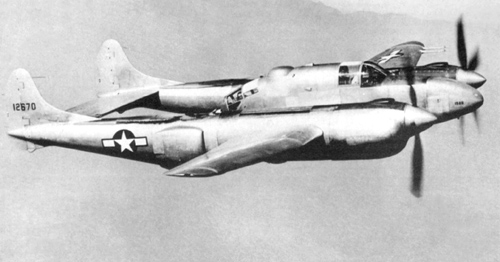 |
XP-58 Chain Lightning
|
src: Wikipédia |
XP-58
Specifications |
| General |
Type:
Heavy fighter |
| Engine |
| 2 × Allison V-3420 24 cylinder | 3000 hp | Pistons |
| Dimensions/Masses |
| Length: 15.07 m | Width:
21.34 m | Height: 4.88 m Weight: 14334 kg | Max. Combat Weight: 17777 kg |
| Performances |
| Max. Speed: 702 km/h | Ceiling: 11645 m| Range: 4265 km |
| Armament |
Guns:
4 × 37 mm (1.46 in) gun or 1 × 75 mm (2.95 in)gun and
2 × .50 in (12.7 mm) MG in nose & 4 × .50 in (12.7
mm) MG in two remotely controlled flexible turrets in the rear. |
Drawings |
Sources:
